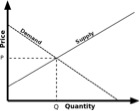Last week we talked about supply and demand. This week we’ll focus on the relationship between those two concepts. The Law of Supply and Demand, illustrated by the graph below, states that there is an equilibrium between supply and demand. This equilibrium represents the place where the greatest amount of goods can be sold at the highest price. Sometimes supply is low and demand is high (this is called a shortage), and therefore the price is high. Other times the supply is high and the demand is low (this is called an excess), and therefore the price is low. One of the reasons this concept exists is because there is competition in the marketplace. We’ll talk about competition in a few weeks.

Let’s revisit our example from last week. We learned that when the Xbox One came out last December, there was high demand and low supply. This means there was a shortage of Xbox Ones at the launch. There were a limited number of consoles but many people wanted to buy one, so the price was high. If Microsoft had more consoles ready, pushing us closer to the market equilibrium, the consoles may have sold for a lower price but the total number of consoles sold would have been greater. In this situation, everyone is better off. More people would have an Xbox One and the company would have made the greatest amount of profit.
For more information on supply and demand, check out these resources available through the St. Louis Federal Reserve’s Economic Lowdown website:
